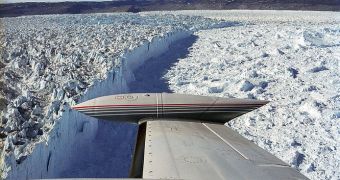The newest studies aimed at calculating the exact extent of ice loss in Greenland reveal that the two of three most important glaciers on the island have thus far lost enough ice that the meltwater can fill Lake Erie, one of the five Great Lakes at the border between Canada and the United States.
According to scientists, the methods used to carry out this research are the most perfected to date, and they provide a high-definition picture of what's going on on Greenland. The island contains vast amounts of ice, that could contribute to rising worldwide ocean levels considerably.
Over the past ten years, only the Helheim glacier has remained somewhat constant. The other two major ice depositories, the Kangerdlugssuaq and Jakobshavn Isbrae glaciers, have lost considerable amounts of ice, and are continuing to do so.
What's worse is that Greenland is the second-largest ice deposit in the world after Antarctica. As such, any changes that take place here have a direct impact on the world's climate. Global warming is believed to be the main cause of glacier collapse around the world.
Together, the three large glaciers account for a massive portion of the ice flowing into the ocean from the island. “Jakobshavn alone drains somewhere between 15 and 20 percent of all the ice flowing outward from inland to the sea,” explains Ian Howat.
The expert, who was the leader of the new study, holds an appointment as an assistant professor of Earth sciences at the Ohio State University (OSU). He is also the author of a paper detailing the findings, which appears in the current issue of the esteemed journal Geophysical Research Letters.
Jakobshavn Isbrae has lost more than 300 billion tons (300 gigatons) of ice over the past 10 years alone, which represents the equivalent of 11 years of snow accumulation. This means that its mass balance (amount of depositing ice vs. amount of flowing ice) is definitely in the red zone.
“Kangerdlugssuaq would have to stop flowing and accumulate snowfall for seven years to regain the ice it has lost,” adds Howat. The expert is also a member of the OSU Byrd Polar Research Center.
Interestingly, Helheim managed to gain about 1/15th of the mass Jakobshavn lost. Researchers still have no idea as to why this happened, and research into this is ongoing, Science Blog reports.
“These glaciers change pretty quickly. They speed up and then slow down. There’s a pulsing in the flow of ice. There’s variability, a seasonal cycle and lots of different changes in the rate that ice is flowing through these glaciers,” Howat concludes.
NASA and the OSU Climate, Water and Carbon Program provided the funds for this investigation.

 14 DAY TRIAL //
14 DAY TRIAL //